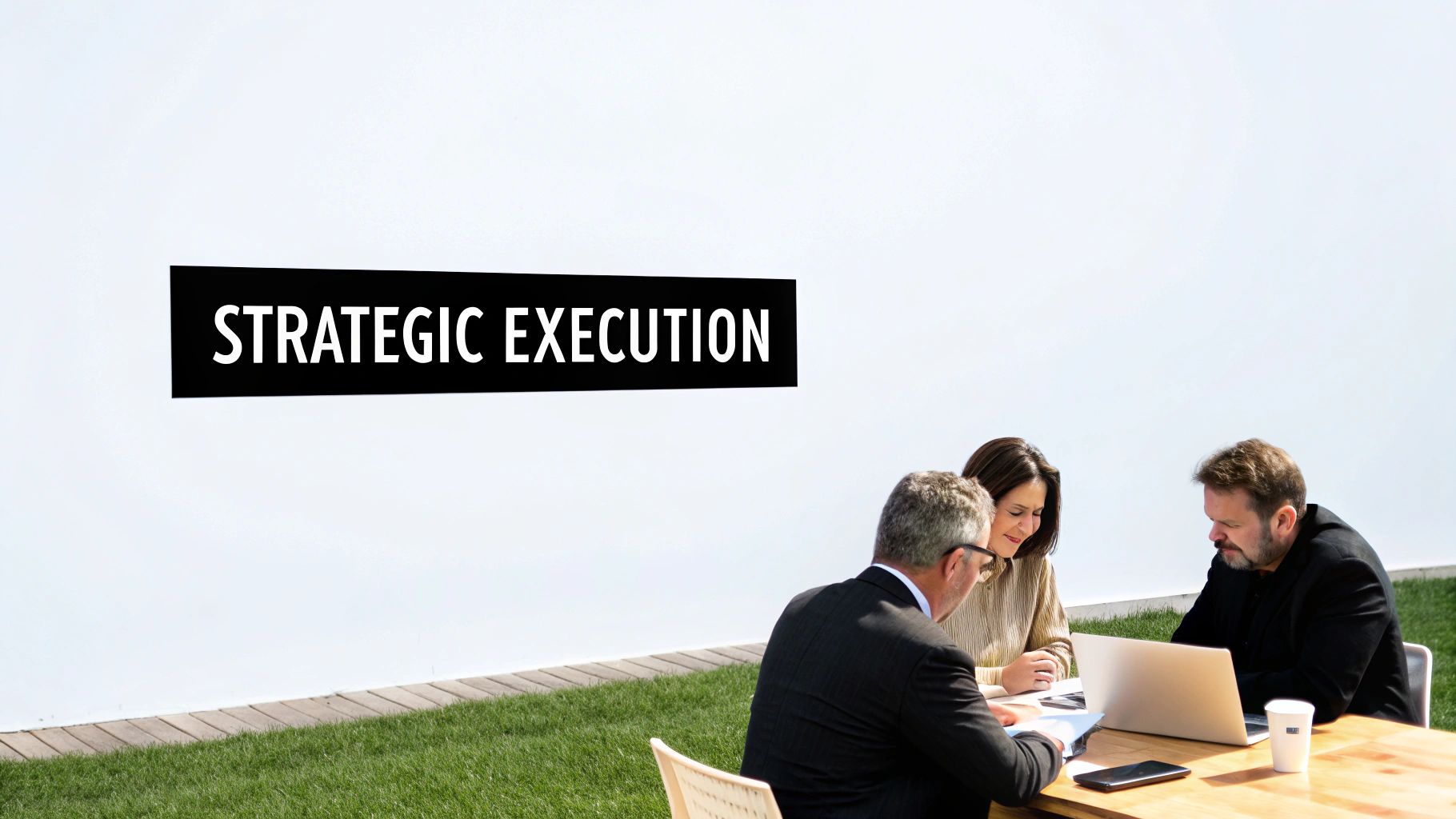The Evolving Landscape of Creative Team Management

The old, rigid, top-down style of creative team management is fading. Project complexity, remote work, and the need to adapt quickly in a fluctuating market demand a new approach. Today, success hinges on building collaborative environments that encourage innovation and empower each team member.
This means stepping away from traditional command-and-control and embracing agile methodologies. It’s about fostering adaptability and responsiveness within the team.
The Shift in Feedback Mechanisms
Think about how feedback used to work. Often, it was delivered in a single, overwhelming meeting. Now, modern creative teams prioritize continuous feedback loops. This provides more focused input throughout a project.
This iterative approach allows for real-time adjustments, ultimately leading to a more polished final product. It also highlights the growing role of specialized platforms like Asana for facilitating this ongoing dialogue.
The Rise of Creative Management Platforms
This evolution is mirrored in the growth of the creative management platform market. In 2024, this market was valued at USD 1.12 billion. Projections show it reaching USD 2.07 billion by 2032, with a CAGR of 8.1% between 2025 and 2032.
This growth underscores the increasing demand for platforms that streamline creative processes. These platforms personalize ad campaigns and allow for multi-channel content distribution, enabling brands to create thousands of targeted ads quickly, boosting marketing efficiency and customer engagement. For deeper insights into these market trends, check out: Fortune Business Insights
The shift to remote work has also spurred the adoption of new tools and strategies for communication and collaboration. With teams spread across different locations, leaders must use technology to stay connected and maintain smooth workflows.
Embracing a New Management Mindset
The modern creative team manager isn't just a project overseer. They are a facilitator, mentor, and strategist. This new role requires excellent communication skills, the ability to empower individuals, and a strong understanding of the creative process.
It's a balancing act: establishing clear goals and deadlines while also providing space for experimentation and creative freedom. Building trust and open communication is crucial.
To further illustrate these evolving approaches, let's look at a comparison:
Evolution of Creative Team Management Approaches
This table shows how creative team management has evolved over time, comparing traditional approaches with modern methodologies
| Management Aspect | Traditional Approach | Modern Approach | Benefits of Modern Approach |
|---|---|---|---|
| Communication | Top-down, infrequent | Continuous, multi-directional | Improved feedback, increased team cohesion |
| Project Management | Rigid, waterfall | Agile, iterative | Enhanced adaptability, faster response to change |
| Team Structure | Hierarchical | Flat, collaborative | Empowered team members, greater innovation |
| Tools & Technology | Limited | Specialized platforms, collaborative software | Streamlined workflows, improved communication |
| Feedback | Formal, infrequent | Continuous, informal | Real-time adjustments, higher quality output |
The table highlights the key differences between traditional and modern creative team management, demonstrating the benefits of adopting more agile and collaborative practices.
Cultivating a Culture of Innovation
This new landscape also necessitates a focus on fostering innovation. This means creating a psychologically safe environment where team members feel comfortable taking risks, trying new ideas, and pushing creative boundaries. Continuous learning and development are also essential to equip teams with the necessary skills for a dynamic environment. Successful creative team management means building a culture of collaboration, embracing technology, and adapting to the evolving needs of creative professionals and the market.
Building High-Performing Creative Teams That Thrive

Building a successful creative team isn't just about hiring talented people. It's about assembling a group where individual skills and personalities complement each other. This creates a dynamic environment that leads to exceptional work. This careful balance is essential for effective creative team management.
Prioritizing Cognitive Diversity
Leading creative organizations recognize the importance of cognitive diversity. This means building teams with diverse perspectives, thinking styles, and problem-solving approaches.
Combining diverse perspectives with technical skill fuels innovation. It allows teams to tackle challenges from multiple angles.
For example, a team of only visual thinkers might miss a solution that a writer with strong conceptual skills could easily identify. This mix of perspectives makes the creative process more well-rounded and effective.
Identifying the Right Talent
Finding candidates with both specialized skills and a collaborative spirit is key. This requires looking beyond portfolios and focusing on how individuals work within a team.
Behavioral interviewing can reveal a candidate’s collaborative nature and adaptability. Assessing past team experience provides insights into their collaborative style. These steps help build a harmonious and productive team.
Establishing Effective Team Structure
Creative directors play a key role in creating team structures. These structures should provide clarity without stifling the creative process. This often involves balancing defined roles with the freedom to explore.
A clear structure ensures everyone understands their responsibilities and how they contribute. It's equally important to encourage experimentation and flexibility within those roles. This balance maintains momentum and encourages innovation.
Onboarding and Development
Effective onboarding is essential for new team members. A well-structured onboarding process helps new hires quickly understand team dynamics, workflows, and project goals.
Personalized development paths are crucial for retention and growth. This shows commitment to individual growth and provides skill enhancement opportunities. These investments benefit both the individual and the team.
Thoughtful creative team management builds teams that deliver outstanding results. This creates an environment where creativity flourishes and business objectives are met. Looking to connect with local talent or find resources for creatives? Visit Creativize for connections and inspiration.
Breaking Down Communication Barriers in Creative Teams

Communication is essential for any successful creative team. However, traditional methods often fall short in the fast-paced and complex world of creative projects. This raises an important question: why do these approaches fail, and how can creative team management improve communication?
From Vague Feedback to Actionable Direction
One common problem is vague feedback. Imagine a client saying, "It needs more pop." What does that even mean? Effective creative team management turns this vague feedback into concrete direction.
For example, instead of "more pop," the feedback could be, "The call to action button needs to be brighter and larger." This clarity helps the team understand the desired outcome.
This shift requires a shared understanding of project goals and a common vocabulary. Building this shared language is crucial for effective communication within the team. Creative team management also needs to balance constructive criticism with preserving the team's creative vision. Feedback should improve the work, not discourage the team.
Establishing Briefing Processes That Inspire
The briefing process is another key element. A poorly executed brief can create confusion. Successful creative teams use frameworks that provide clear direction while allowing for creative freedom.
This involves outlining the project scope, target audience, and key message. It also means providing examples of successful projects and establishing clear communication channels. This structured approach ensures everyone is on the same page from the start.
This leads to fewer misunderstandings and revisions, making creative team management more efficient. You might find this resource helpful: How to Master Creative Project Briefings. In-house creative teams often face communication challenges. 94% of stakeholders believe they communicate clearly, while only 69% of creative teams agree. This highlights the need for better communication strategies. More statistics on creative operations can be found here: Lytho Creative Operations Statistics.
Facilitating Critique Sessions That Elevate
Critique sessions are vital to the creative process. However, if not handled well, they can be demotivating. Creative team management should facilitate these sessions to encourage open dialogue and constructive feedback.
This means creating a safe environment where team members feel comfortable sharing their thoughts. It also requires setting clear guidelines for giving and receiving feedback.
Creating Feedback Channels Where Everyone is Heard
Finally, robust feedback channels are essential. This ensures that every team member, regardless of their role, feels heard and valued. These channels might include regular team meetings, online platforms like Slack, or even anonymous feedback tools.
Multiple feedback avenues create a sense of ownership and encourage participation. This collaborative approach ensures everyone is invested in the project’s success. Effective communication is the foundation of successful creative team management. It leads to fewer revisions, less frustration, and a more fulfilling creative process.
Crafting Workflows That Unleash Creative Potential
The right workflow can empower a creative team. The wrong one can stifle it. Finding the right balance—structure without hindering innovation—is the key to unlocking a team's full potential. This section explores workflow frameworks that achieve this balance.
Identifying and Eliminating Bottlenecks
The first step towards a better workflow is identifying bottlenecks. These are the hidden obstacles that slow down progress and negatively impact team morale. Think of them as friction points in your creative process.
For example, if projects consistently stall during approvals, examine that process. Are too many stakeholders involved? Is the feedback process unclear? Identifying these points is the first step toward smoother operations.
Adapting Methodologies for Creative Work
Leading creative organizations often blend elements from various methodologies. These might include Agile development, design thinking, and traditional project management. The goal is a hybrid approach tailored for creative work.
This could involve adopting short, iterative sprints for project phases. It might also mean incorporating user feedback early in the design process. Or, it could involve using project management software to track progress. The key is finding the right combination for your specific team.
Managing Project Intake and Approval
Effective creative team management begins with project intake. A clear system prevents overload and ensures the team focuses on the right priorities. This lays the groundwork for successful execution.
A streamlined approval process keeps projects moving. This means clearly defined roles, responsibilities, and deadlines for each stage. This clarity minimizes confusion and prevents unnecessary delays.
For example, a platform like Ziflow centralizes feedback. This ensures all stakeholders can efficiently review and approve assets.
Implementing Quality Control Measures
Quality control is crucial, but it shouldn't create roadblocks. The goal is to balance high standards with a streamlined process. This ensures quality without excessive bureaucracy.
This could involve checklists for different project phases. It could also mean establishing clear style guides or conducting regular peer reviews. These measures improve quality without slowing down the creative process.
The aim is to empower the team, not burden them with administrative tasks. A strong creative team is a more productive and innovative team.
To connect with creative professionals or boost your team’s skills, visit Creativize for talent, resources, and insights. Creating the right environment allows creativity to thrive, leading to both individual and organizational success.
To help you select the right platform for managing your creative workflow, take a look at the comparison table below:
Creative Workflow Management Platforms Comparison: This table compares key features and benefits of popular creative management platforms to help teams select the right tool for their needs.
| Platform | Key Features | Best For | Pricing Range | Integration Capabilities |
|---|---|---|---|---|
| Asana | Task management, project timelines, collaboration tools | Marketing teams, general project management | Free – $24.99/user/month | Wide range of integrations with other business tools |
| Monday.com | Visual workflow management, customizable dashboards, automation | Marketing, sales, operations teams | Free – $16/user/month | Integrates with popular CRM, marketing, and communication tools |
| Wrike | Project planning, resource management, time tracking | Marketing, creative, product development teams | Free – $24.80/user/month | Robust integrations with Adobe Creative Cloud, Salesforce, and others |
| Ziflow | Online proofing, review and approval workflows, version control | Creative teams, marketing teams | Contact for pricing | Integrates with project management and file sharing platforms |
This table provides a quick overview of some popular options. Choosing the right platform depends on your team’s specific needs and budget. Consider factors like team size, project complexity, and required integrations when making your decision.
The Art of Balancing Creative Freedom With Strategic Goals

Creative teams thrive when they have the freedom to explore new ideas. However, they also need guidance and direction. This section explores the delicate balance between creative freedom and strategic goals. This balance is crucial for effective creative team management.
It's a balancing act that allows teams to push boundaries while delivering impactful results. This delicate balance fosters innovation while ensuring the team's efforts contribute to the overall business objectives. Successfully navigating this balance is key to a thriving and productive creative team.
Translating Business Objectives Into Creative Challenges
Business objectives can often seem dry and uninspiring to creative teams. Skilled creative leaders can transform these objectives into engaging challenges. These challenges can energize teams and inspire innovative solutions. This reframing is essential for maintaining motivation and driving creativity.
For example, the business objective of increasing brand awareness could be reframed. The team might be challenged to create a viral marketing campaign. This approach sparks creativity. It also aligns the team with the overall business strategy, ensuring their work contributes directly to the company's success.
Involving Creative Voices in Strategic Planning
Creative teams shouldn't be excluded from strategic planning. Involving them early ensures alignment and fosters a sense of ownership. Their unique perspectives can provide invaluable insights, leading to more innovative and effective strategies. Early involvement can significantly impact the overall success of the project.
Include creative representatives in strategy meetings. Actively seek their input. Their insights can lead to more creative and effective solutions. This collaborative approach integrates the creative vision with the overall strategic direction. You might be interested in: How to Master Creative Team Integration.
Measuring Creative Performance
Measuring creative performance is complex. It's not simply tracking traditional metrics. It requires evaluating both artistic merit and business outcomes. This holistic approach recognizes the dual nature of creative work—balancing artistry with practical results. It's about acknowledging both the creative process and the impact it has on the business.
Key performance indicators (KPIs) could include awards won, social media engagement, and impact on sales. It's important to define KPIs that reflect the specific goals of each project. This targeted approach provides a more accurate measure of creative success, ensuring the evaluation is relevant and meaningful.
Defending Creative Exploration
Short-term pressures can hinder long-term creative vision. Effective creative team management involves defending creative exploration. This is important even with tight deadlines and budget constraints. Protecting this exploration is crucial for fostering innovation and groundbreaking work.
This means advocating for time and resources for experimentation and research. It also involves explaining the value of creative exploration to stakeholders. This might include highlighting the potential for long-term growth and maintaining a competitive edge through innovation.
Fostering a Culture of Trust and Open Communication
Building trust and open communication is essential within the team. This allows team members to take risks. They can share ideas freely. This psychological safety creates a more innovative and collaborative environment where creativity can truly flourish. Open communication is the bedrock of a successful and innovative creative team.
Encourage open dialogue. Provide constructive feedback. Celebrate both successes and failures. This builds confidence and encourages further experimentation, ultimately empowering the team to push creative boundaries and deliver exceptional results. By balancing creative freedom with strategic goals, creative teams can consistently deliver breakthrough creative work and measurable business impact.
Building a Culture Where Innovation Naturally Flourishes
Innovation isn't something you can suddenly turn on; it's more like a plant you carefully nurture. This means moving beyond superficial benefits and creating an environment where creative risks are not just accepted, but actively encouraged. Effective creative team management hinges on this principle.
Psychological Safety: The Foundation of Creative Risk-Taking
At the core of any truly innovative team is psychological safety. This is the shared understanding that team members can freely express themselves, share unconventional ideas, and even make mistakes without fear of repercussions. It's the rich soil where new ideas can take root and blossom.
This isn't about removing accountability. It's about creating a space where calculated risks are viewed as learning opportunities, not threats. For example, if a team member suggests an unusual campaign idea that doesn't succeed, the focus should be on the lessons learned, not on blaming individuals. This approach encourages future innovative thinking.
Designing Workspaces That Spark Collaboration
The physical and digital environments where your team operates significantly impact innovation. A sterile, isolated office doesn't exactly inspire creative collaboration. Instead, aim for spaces that actively promote interaction and the exchange of ideas.
This could involve designated brainstorming areas, adaptable workspaces easily reconfigured for different projects, or even virtual collaboration platforms like Slack that facilitate seamless communication and file sharing, regardless of location. The goal is to make collaboration feel natural and easy.
Implementing Innovation Rituals That Energize
Innovation rituals aren't about scheduling more meetings. They're about integrating creative practices into the team's regular workflow. These rituals can take many forms, from structured brainstorming or mind mapping sessions to cross-disciplinary experiments that bring together diverse skill sets.
Consider regular "creative sprints" where team members dedicate focused time to exploring new ideas. Or, try "innovation challenges" that encourage the team to tackle a specific problem from different angles. These rituals can revitalize the creative process and lead to unexpected breakthroughs. Learn more in our article about How to Master Innovation Rituals.
Addressing Creative Burnout: Maintaining Sustainable Energy
Even the most enthusiastic creative teams can experience burnout, especially when dealing with demanding projects and tight deadlines. This is where effective creative team management is crucial. Ignoring burnout can decrease productivity, lower the quality of work, and even lead to team members leaving.
Addressing burnout requires a multifaceted approach. This could involve providing access to resources for stress management and mental well-being, encouraging regular breaks and time off, and promoting open communication about workload and individual capacity. Celebrating successes, both big and small, is also important to remind the team of their achievements and maintain a positive outlook.
By prioritizing psychological safety, designing inspiring workspaces, implementing energizing innovation rituals, and actively addressing creative burnout, you can cultivate a culture where innovation thrives. This environment empowers your team to consistently deliver groundbreaking creative work while maintaining a sustainable pace.
Ready to connect with top local creative talent and build a thriving team? Visit Creativize today to explore a world of creative possibilities.

